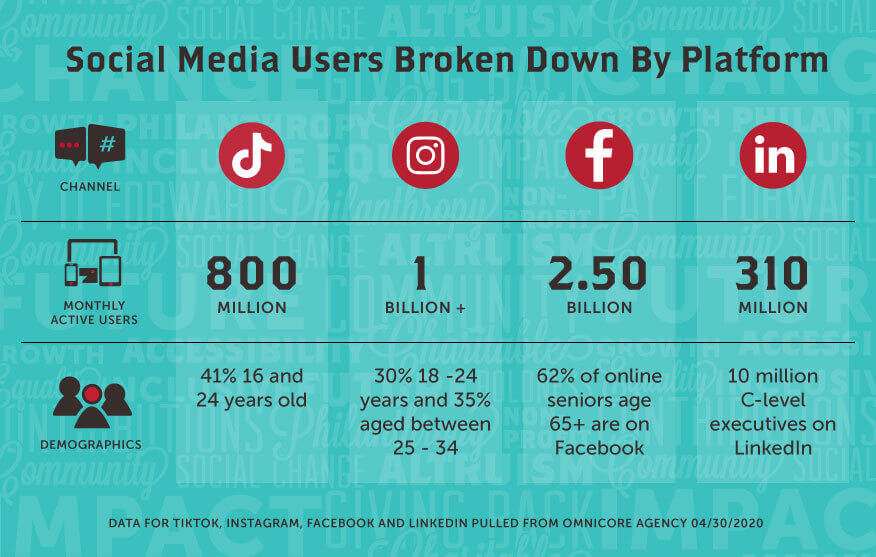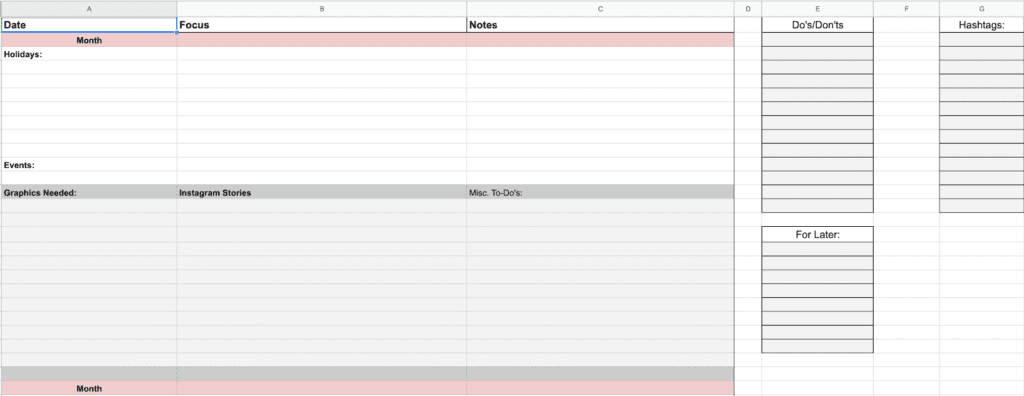
Why Social Media?
If you’re a small business owner in Sacramento, social media management may be one of the last things on your mind, but it shouldn’t be! With shelter-in-place regulations enforced throughout the state, you better believe the community you traditionally serve in-person, is online, connecting with brands who are meeting them where they are. According to Market Watch, Facebook’s services including their social networking sites, messaging, and live-streaming platforms have been seeing users in record numbers since the onset of the global pandemic. It could be argued that marketing to your audience is more important than ever and social media is affordable and easy to use—but it’s often not taken seriously or used at its utmost potential. If you’re a small business owner looking to handle social media management on a budget — this post is for you. We’ll cover everything from strategy to analytics, and all the important bits in between.
So, let’s dive into social media maintenance and how to do it properly. Now, before we get into the management of the actual channels, we need to determine which social media channels are best for you. Oftentimes folks ask me, “Well, shouldn’t I be on Instagram?” and they’re usually surprised that I don’t fly off the bat with a “Yes.” The social media platforms that are best for you, are unique to you and the audience you serve. Here’s what I mean:
- Twitter is THE social platform for quick updates and news related items. With only 280 characters per tweet, Twitter is fast-paced. You’ll need to keep things short and sweet, here.
- We like to call Facebook “The Backyard Barbeque” of social media platforms. It’s where you connect with family and friends and where Silver Surfers spend most of their online time.
- Contrast that with Instagram where you see a lot more millennial and teen usage. You had better get access to some engaging imagery to compete in this arena.
- As the third most downloaded non-gaming app of the year and the most downloaded app in the Apple App Store, TikTok should not be left off the list. This platform is favored by Gen Zers, so if your demographic is on the younger side, you may need to focus your efforts here.
- Snapchat, Pinterest, and LinkedIn may also work for you, just be sure to follow your audience, if that’s where they are, that’s where you belong.

All of this is to say that your social media management will be most successful when you meet your audience on the platforms they prefer to use and where they already are. So, running an ad that targets Boomers on Facebook will do much better than an ad that targets Boomers on TikTok—they just aren’t on that channel. Got it? Good!
Setting Your Perfect Game Plan
Now that you know where you’ll be pushing out your awesome content, it’s time to set the perfect game plan—I’m talking strategy, y’all! And to ensure the success of any social media strategy there are a few ingredients you must have on hand:
- SMART goals: Specific, Measurable, Attainable, Relevant, Time-based. No room for stupidity here. An example could be to grow social media following by 5% in one month.
- Key Performance Indicators (KPI): It’s a bit self-explanatory but we’ll break it down for those that aren’t as quick: if you want to grow your following on social media, your KPI would be the number of new followers. Meaning, to track the success of growing followers, your performance indicator of success would be the number of new followers per month.
- Measurement and Evaluation: How do you know it’s working if you aren’t keeping track? After one month, measure your new growth and evaluate if your tactics are working. If they aren’t, it’s time for a course-correction.
Related: 7 Tips For Auditing Your Social Media
Armed with these tools, your strategy is damn-near foolproof. But we’re not quite done just yet, this is just the bare bones. After you write down your goals, KPI’s, and measurement techniques, it’s time to focus the content.
What’s A Content Calendar, Anyways?
We’re so happy you asked! A content calendar, my friends, is a high-level overview of the content focus for any given time period—it outlines who is doing what, where, and when. Content calendars can be used to manage a number of things including blogs, newsletters, and social media. At Uptown Studios, we’re big on using content calendars to help keep things focused for our clients—and for ourselves. Social media content calendars typically focus on social media content themes, upcoming events around Sacramento, and the specific platforms to push content out on. Depending on the client and their level of needs, we’ve developed content calendars in word documents, spreadsheets and even third-party apps like Airtable, which is a lot of fun to use, pretty to look at, and my personal favorite right now (although it might be difficult for the novice learner.) If you’re having trouble visualizing what a basic social media content calendar looks like, that’s okay—we got you. You can download our free content calendar template to help you keep communications focused, for you or your small business, below. You’re welcome.

Download our free content calendar now!
Download Calendar
Staying on Schedule
Our little game plan is coming along quite nicely if you ask me. Now, let’s get these posts up! Sure, you can post manually and set reminders, calendar notifications, or even use Facebook’s built-in scheduler to push your content out, but we prefer something a bit more streamlined. Enter social media scheduling tools. Scheduling social media posts in advance is no new game-changer, so it surprised me how many organizations still aren’t using these (oftentimes) free services. Utilizing a scheduler saves time and frees up your day so that posts are going out while you are closing business deals (or whatever you like to do in your free time). If you’ve been a social media manager in any capacity, you understand how much time goes into creating and pushing out content and have probably found a scheduler that you swear by. An entire blog can be written on the differences between schedulers and which ones are the best for social media managers or specific channels. Here at Uptown Studios, we have a paid plan with Sprout Social. I’ve also used Hootsuite’s paid and free membership, Facebook’s built-in scheduler, and Later’s paid and free versions. If you’re just starting out, I’d recommend diving into Hootsuite. They have a stellar free version, their monthly plans are very affordable, and it’s pretty versatile with scheduling capabilities.
So, you’ve picked your scheduler, now what? First things first, it will probably serve you right to watch a quick tutorial on how to use the user interface for whatever social media scheduler you chose, in order to get going and connect channels. Uptown Studios is always available to help, so, shoot me an email if you need any assistance with getting connected to your social media scheduler, Kiara@uptownstudio.net, and we’ll get you set up for success. Pro tip: at the beginning of each week/month set a good chunk of time aside and load all the content from your social media content calendar into your scheduler for effortless and stress-free posting. You’ll thank yourself (and hopeful me!) later.
In Need Of Social Media Management? We Have A Team Of Marketing Professionals That Will Take Your Business To The Next Level.
Getting Social on Social Media
Look at you! You social media manager in the making, we’ve come along way! But a girl’s got to ask: when’s the last time you actually engaged with someone else’s comment, post, or share? I thought so! Come on. It’s called social media for a reason, and being social goes a long way. If you aren’t liking, commenting, and sharing content from like-minded organizations, clients, or partners, why would they engage with your social media content? With all of your content scheduled in advance, you now have the time to sit back and do just that. There’s so much going on in Sacramento, don’t be afraid to join the conversation!
How do you know it’s working?
Remember those KPIs I mentioned earlier? Here is where those come in. For example, say you set a goal of increasing your total follower count by 5% in a month. That can be hard to do! At the end of your 30 days, take some time to do a little evaluation. In 30 days, how many followers have you gained? If you were successful, great! We recommend taking it a step further and examining your content. What type performed best? On what day did you earn the highest number of new followers? These observations will allow you to learn what is working and what is not. Especially if you aren’t successful at your goal, looking at how content performed will really help. Did one particular post do really well? Create more content just like it! Evaluations are the best way to learn what kind of content your audience likes the most. And don’t forget: once you’ve aced your first goal, set another.
Conclusion
Social media management takes time and patience. But really, once you get a system down and rolling, it isn’t all that hard. Social media is supposed to be fun. So make sure you are actually enjoying yourself. No matter how organized, scheduled, and goal-oriented you are, if you’re not enjoying yourself while using social media it is likely that your followers will pick up on that and feel turned off. Let yourself make mistakes and don’t be afraid to try new things. If you get stuck, holler at us! We love to help Sacramento businesses.
Blog


